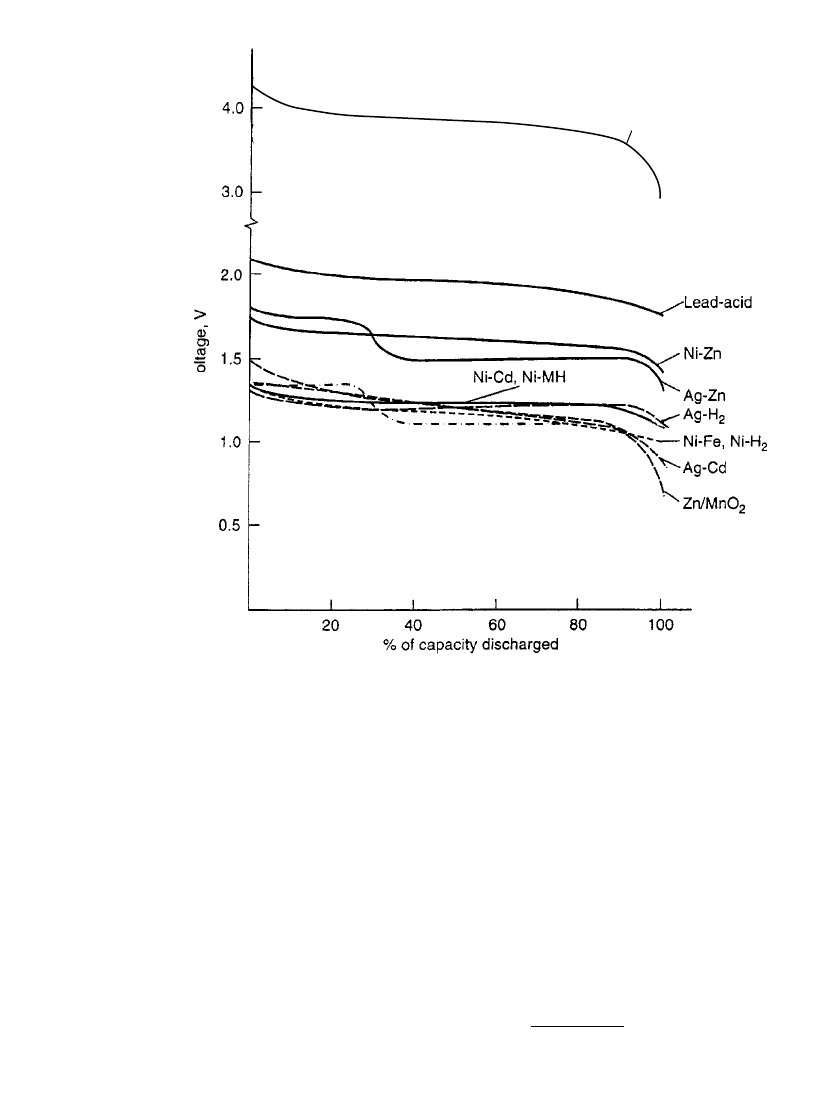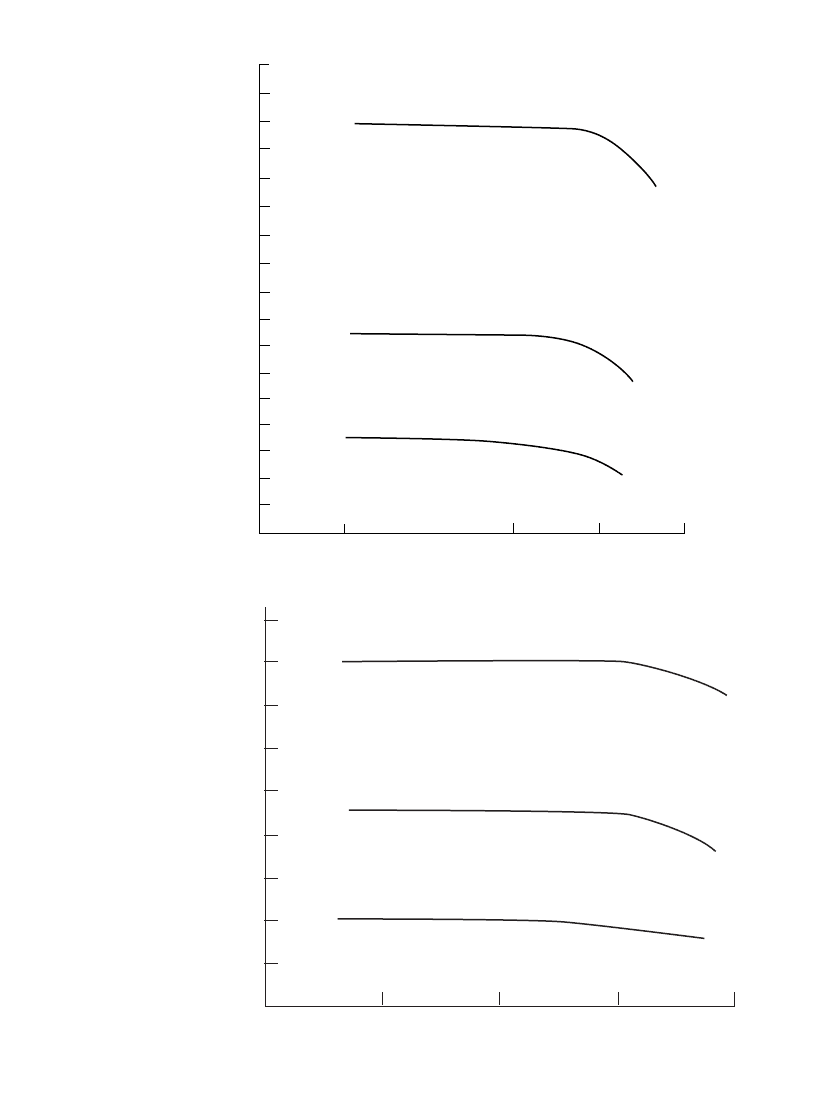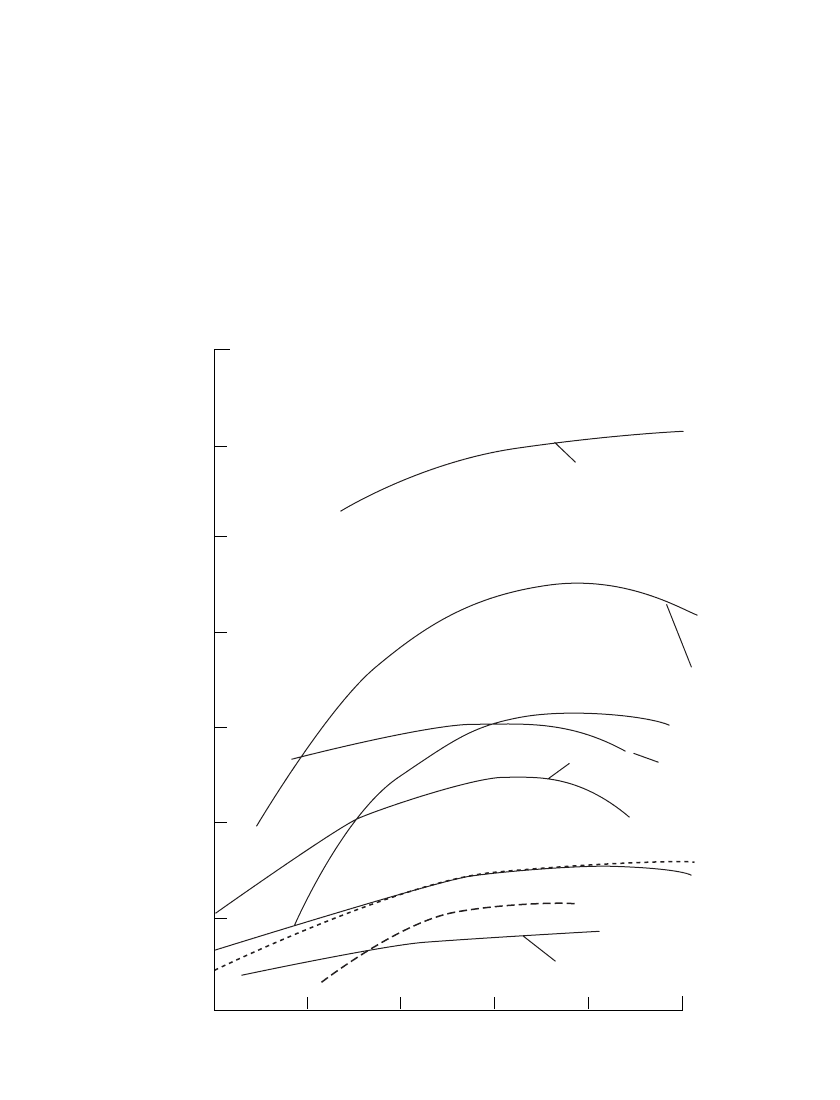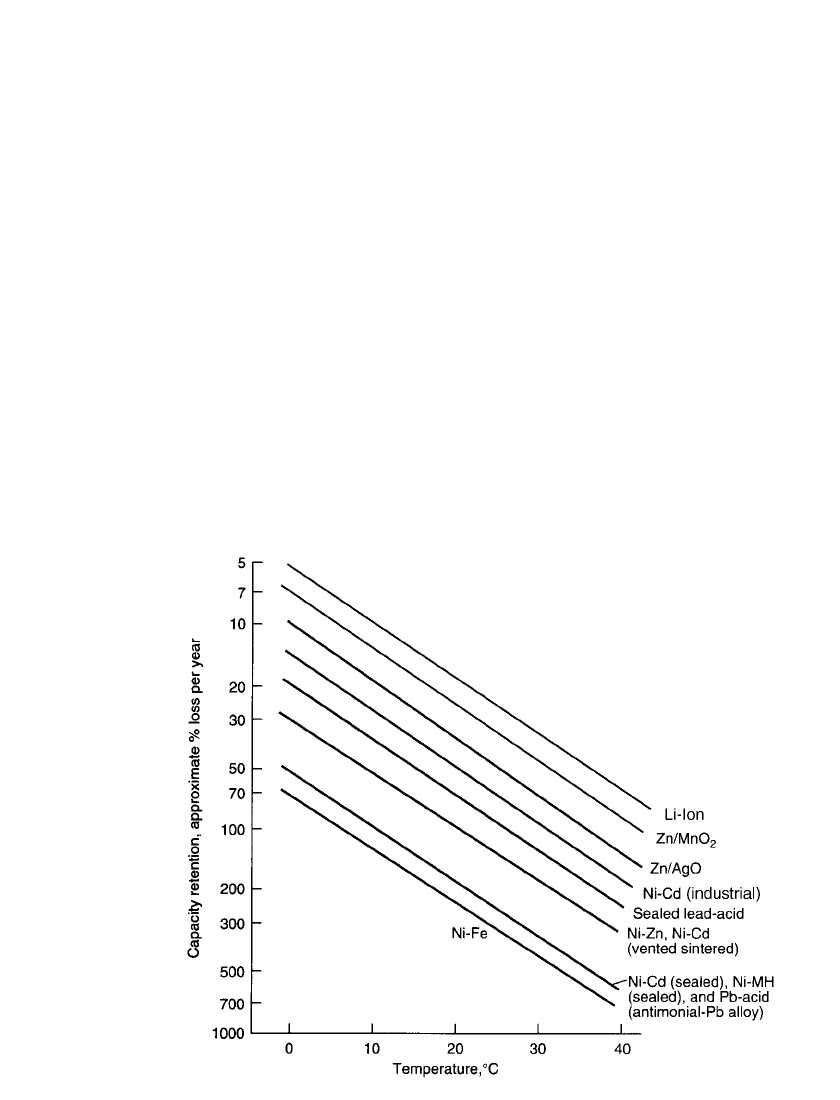Linden D., Reddy T.B. (eds.) Handbook of batteries
Подождите немного. Документ загружается.


22.10 CHAPTER TWENTY-TWO
Nickel-Iron Batteries. The nickel-iron battery was important from its introduction in 1908
until the 1970s, when it lost its market share to the industrial lead-acid battery. It was used
in materials-handling trucks, mining and underground vehicles, railroad and rapid-transit
cars, and in stationary applications. The main advantages of the nickel-iron battery, with
major cell components of nickel-plated steel, are extremely rugged construction, long life,
and durability. Its limitations, namely, low specific energy, poor charge retention, and poor
low-temperature performance, and its high cost of manufacture compared with the lead-acid
battery led to a decline in usage.
Silver Oxide Batteries. The silver-zinc (zinc/silver oxide) battery is noted for its high
energy density, low internal resistance desirable for high-rate discharge, and a flat second
discharge plateau. This battery system is useful in applications where high energy density is
a prime requisite, such as electronic news gathering equipment, submarine and training target
propulsion, and other military and space uses. It is not employed for general storage battery
applications because its cost is high, its cycle life and activated life are limited, and its
performance at low temperatures falls off more markedly than with other secondary battery
systems.
The silver-cadmium (cadmium/ silver oxide) battery has significantly longer cycle life and
better low-temperature performance than the silver-zinc battery but is inferior in these char-
acteristics compared with the nickel-cadmium battery. Its energy density, too, is between that
of the nickel-cadmium and the silver-zinc batteries. The battery is also very expensive, using
two of the more costly electrode materials. As a result, the silver-cadmium battery was never
developed commercially but is used in special applications, such as nonmagnetic batteries
and space applications. Other silver battery systems, such as silver-hydrogen and silver-metal
hydride couples, have been the subject of development activity but have not reached com-
mercial viability.
Nickel-Zinc Batteries. The nickel-zinc (zinc /nickel oxide) battery has characteristics mid-
way between those of the nickel-cadmium and the silver-zinc battery systems. Its energy
density is about twice that of the nickel-cadmium battery, but the cycle life previously has
been limited due to the tendency of the zinc electrode toward shape change which reduces
capacity and dendrite formations, which cause internal short-circuiting.
Recent development work has extended the cycle life of nickel-zinc batteries through the
use of additives in the negative electrode in conjunction with the use of a reduced concen-
tration of KOH to repress zinc solubility in the electrolyte. Both of these modifications have
extended the cycle life of this system so that it is now being marketed for use in electric
bicycles, scooters and trolling motors in the United States and Asia.
Hydrogen Electrode Batteries. Another secondary battery system uses hydrogen for the
active negative material (with a fuel-cell-type electrode) and a conventional positive elec-
trode, such as nickel oxide. These batteries are being used exclusively for the aerospace
programs which require long cycle life at low depth of discharge. The high cost of these
batteries is a disadvantage which limits their application. A further extension is the sealed
nickel/metal hydride battery where the hydrogen is absorbed, during charge, by a metal
alloy forming a metal hydride. This metal alloy is capable of undergoing a reversible hy-
drogen absorption-desorption reaction as the battery is charged and discharged respectively.
The advantage of this battery is that its specific energy and energy density are significantly
higher than that of the nickel-cadmium battery. The sealed nickel-metal hydride battery,
manufactured in small prismatic and cylindrical cells, is being used for portable electronic
applications and are being employed for other applications including hybrid electric vehicles.
Larger sizes are finding use in electric vehicles (see Chap. 30).

SECONDARY BATTERIES—INTRODUCTION 22.11
Zinc/ Manganese Dioxide Batteries. Several of the conventional primary battery systems
have been manufactured as rechargeable batteries, but the only one currently being manu-
factured is the cylindrical cell using the zinc/ alkaline-manganese dioxide chemistry. Its major
advantage is a higher capacity than the conventional secondary batteries and a lower initial
cost, but its cycle life and rate capability are limited.
Lithium Ion Batteries. Lithium ion batteries have emerged in the last decade to capture
over half of the sales value of the secondary consumer market, with applications such as
laptop computers, cell phones and camcorders (known as the ‘‘Three-C’’ market). Production
capacity has recently been estimated to be 75 million/cells per month,
3
These cells provide
high energy density and specific energy (see Fig. 22.1) and long cycle life, typically greater
than 1000 cycles @ 80% depth of discharge. When built into batteries, battery management
circuitry is required to prevent over charge and over discharge, both of which are deleterious
to performance. The circuits may also provide an indication of state-of-charge and safety
features in the case of an over-current or an over-heating condition (see Chap. 5). More
detailed information on this subject may be found in Chap. 35.
22.3 COMPARISON OF PERFORMANCE CHARACTERISTICS FOR
SECONDARY BATTERY SYSTEMS
22.3.1 General
The characteristics of the major secondary systems are summarized in Table 22.3. This table
is supplemented by Table 1.2, which lists several theoretical and practical electrical char-
acteristics of these secondary battery systems. A graphic comparison of the theoretical and
practical performances of various battery systems is given in Fig. 3.3. This shows that up to
only about 20 to 30% of the theoretical capacity of a battery system is attained under practical
conditions as a result of design and the discharge requirements.
It should be noted, as discussed in detail in Chaps. 3 and 6, that these types of data and
comparisons (as well as the performance characteristics shown in this section) are necessarily
approximations, with each system being presented under favorable discharge conditions. The
specific performance of a battery system is very dependent on the cell design and all the
detailed and specific conditions of the use and discharge-charge of the battery.
A qualitative comparison of the various secondary battery systems is presented in Table
22.4. The different ratings given to the various designs of the same electrochemical system
are an indication of the effects of the design on the performance characteristics of a battery.

22.12 CHAPTER TWENTY-TWO
TABLE 22.3 Characteristics of the Major Secondary Battery Systems
Common name
Lead-acid
SLI Traction Stationary Portable
Nickel-cadmium
Vented
pocket
plate
Vented
sintered
plate Sealed FNC
Chemistry:
Anode
Cathode
Electrolyte
Pb
PbO
2
H
2
SO
4
(aqueous
solution)
Pb
PbO
2
H
2
SO
4
(aqueous
solution)
Pb
PbO
2
H
2
SO
4
(aqueous
solution)
Pb
PbO
2
H
2
SO
4
(aqueous
solution)
Cd
NiOOH
KOH
(aqueous
solution)
Cd
NiOOH
KOH
(aqueous
solution)
Cd
NiOOH
KOH
(aqueous
solution)
Cd
NiOOH
KOH
(aqueous
solution)
Cell voltage
(typical), V:
Nominal
Open circuit
Operating
End
2.0
2.1
2.0–1.8
1.75
(lower operating
and end voltage
during cranking
operation)
2.0
2.1
2.0–1.8
1.75
2.0
2.1
2.0–1.8
1.75
(except when on
float service)
2.0
2.1
2.0–1.8
1.75
(where cycled)
1.2
1.29
1.25–1.00
1.0
1.2
1.29
1.25–1.00
1.0
1.2
1.29
1.25–1.00
1.0
1.2
1.35
1.25–0.85
1.00–0.65
Operating
temperatures,
⬚C
⫺40 to 55 ⫺20 to 40 ⫺10 to 40
c
⫺40 to 60 ⫺20 to 45 ⫺40 to 50 ⫺40 to 45 ⫺50 to 60
Specific energy
and energy
density (at
20
⬚C)
Wh/kg
Wh/L
35
70
25
80
10–20
50–70
30
90
20
40
30–37
58–96
35
100
10–40
15–80
Discharge
profile
(relative)
Flat Flat Flat Flat Flat Very flat Very flat Flat
Power density High Moderately
high
Moderately
high
High High High Moderate
to high
Very high
Self-discharge
rate (at 20
⬚C),
% loss per
month
b
20–30
(Sb-Pb)
2–3
(maintenance-
free)
4–6 — 4–8 5 10 15–20 10–15
Calendar life,
years
3–6 6 18–25 2–8 8–25 3–10 2–5 5–20
Cycle life,
cycles
c
200–700 1500 — 250–500 500–2000 500–2000 300–700 500–10,000
Advantages Low cost, ready
availability, good
high-rate, high- and
low-temperature
operation (good
cranking service),
good float service,
new maintenance-
free designs
Lowest cost of
competitive
systems (also see
SLI)
Designed for
‘‘float’’ service
lowest cost of
competitive
systems (also see
SLI)
Maintenance-
free: long life on
float service;
low- and high-
temperature
performance; no
‘‘memory’’
effect; operates
in any position
Very rugged, can
withstand
physical and
electrical abuse;
good charge
retention, storage
and cycle life
lowest cost of
alkaline batteries
Rugged;
excellent storage;
good specific
energy and high-
rate and low-
temperature
performance
Sealed, no
maintenance;
good low-
temperature and
high-rate
perfomance; long
life cycle;
operates in any
position
Sealed, no
maintenance,
high power
capability even at
low temperature,
long cycle life at
low depth of
discharge, fast
charging
Limitations Relatively low
cycle life; limited
energy density;
poor charge
retention and
storability;
hydrogen evolution
Low energy
density; less
rugged than
competitive
systems;
hydrogen
evolution
Hydrogen
evolution
Cannot be stored
in discharged
condition; lower
cycle life than
sealed nickel-
cadmium;
difficult to
manufacture in
very small sizes
Low energy
density
High cost;
‘‘memory’’
effect; thermal
runaway problem
Sealed lead-acid
battery better at
high temperature
and float service,
‘‘memory’’ effect
Lower energy
density than
sintered plate
design
Major battery
types available
Prismatic cells;
30–200 Ah at
20-h rate
Based on
positive plate
design; 45–200
Ah per positive
plate
Based on
positive plate
design: 5–400
Ah per positive
to 1440 Ah plate
Sealed cylindrical
cells; 2.5–25 Ah;
prismatic cells;
to 1440 Ah
Prismatic cells;
5–1300 Ah
Prismatic cells;
1.5–100 Ah
Button cells to
0.5 Ah;
cylindrical cells
to 10 Ah
Prismatic designs
to 450 Ah
a
Based on C / LiCoO
2
lithium-ion battery (see Chap. 35) (characteristics vary with battery system and design).
b
Self-discharge rate usually decreases with increasing storage time.
c
Dependent on depth of discharge.
d
High rate Zn/ AgO battery.
e
Low rate Zn/AgO battery.

SECONDARY BATTERIES—INTRODUCTION 22.13
Nickel-iron
(conven-
tional) Nickel-zinc
Zinc / silver
oxide
(silver-zinc)
Cadmium /
silver oxide
(silver-
cadmium)
Nickel-
hydrogen
Nickel-
metal
hydride
Rechargeable
‘‘primary’’
types,
Zn / MnO
2
Lithium ion
systems
a
Fe
NiOOH
KOH
(aqueous
solution)
Zn
NiOOH
KOH
(aqueous
solution)
Zn
AgO
KOH
(aqueous
solution)
Cd
AgO
KOH
(aqueous
solution)
H
2
NiOOH
KOH
(aqueous
solution)
MH
NiOOH
KOH
(aqueous
solution)
Zn
MnO
2
KOH
(aqueous
solution)
C
LiCoO
2
Organic
solvent
1.2
1.37
1.25–1.05
1.0
1.65
1.73
1.6–1.4
1.2
1.5
1.86
1.7–1.3
1.0
1.1
1.41
1.4–1.0
0.7
1.4
1.32
1.3–1.15
1.0
1.2
1.4
1.25–1.10
1.0
1.5
1.5
1.3–1.0
1.0
4.0
4.1
4.0–3.0
3.0
⫺10 to 45 ⫺10 to 50 ⫺20 to 60 ⫺25 to 70 0 to 50 ⫺20 to 50 ⫺20 to 40 ⫺20 to 50
30
55
50–60
80–120
105
d
180
70
120
64 (CPV)
105 (CPV)
75
240
85
250
150
400
Moderately flat Flat Double plateau Double plateau Moderately flat Flat Sloping Sloping
Moderate to low High Very high (for
high rate-design)
Moderate to high Moderate Moderate to high Moderate Moderate; high
in prismatic
designs
20–40
⬍20 5 5 Very high except
at low temp.
15–25 2
8–25 — 2 3 (vented)
4 (sealed)
— 2–5
2000–4000 500 50–100 300–800 1500–6000
40,000 at 40%
(DOD)
300–600 15–25 1000
⫹
Very rugged, can
withstand
physical and
electrical abuse;
long life (cycling
or stand)
High energy
density; relatively
low cost; good
low-temperature
performance
High energy
density; high
discharge rate;
low self-
discharge
High-energy
density; low self-
discharge, good
cycle life
High energy
density; long
cycle life at low
DOD; can
tolerate
overcharge
High energy
density; sealed,
good cycle life
Good shelf life;
low cost
High specific
energy and
energy density;
low self-
discharge; long
cycle life
Low power and
energy density;
high self-
discharge;
hydrogen
evolution; high
cost and high
maintenance cost
Improved cycle
life at reduced
specific energy
High cost; low
cycle life;
decreased
performances at
low temperatures
High cost;
decreased
performance at
low temperatures
High initial cost;
self-discharge
proportional to H
2
presure and
temperature
Intermediate in
cost between
NiCad and Li
Ion
Limited cycle
life; low drain
applications;
small size only
Lower rate
(compared to
aqueous systems)
Decreasing
significance in
developed
countries
In production for
electric bicycles
and scooters and
trolling motors:
2–100 Ah sizes
Prismatic cells:
⬍1 to 1000 Ah;
special types to
5000 Ah
Prismatic cells:
⬍1 to 1000 Ah
Aerospace
applications (up
to 100 Ah)
Button and
cylindrical cells
to 4.1 Ah, large
prismatics to 100
Ah
Cylindrical cells
to 10 Ah
Cylindrical and
prismatic cells to
100 Ah

22.14 CHAPTER TWENTY-TWO
TABLE 22.4 Comparison of Secondary Batteries*
System
Energy
density
Power
density
Flat
discharge
profile
Low-
temp-
erature
operation
Charge
retention
Charge
acceptance
Effic-
iency Life
Mech-
anical
prop-
erties Cost
Lead-acid:
Pasted
Tubular
Plante´
Sealed
4
4
5
4
4
5
5
3
3
4
4
3
3
3
3
2
4
3
3
3
3
3
3
3
2
2
2
2
3
2
2
3
5
3
4
5
1
2
2
2
Lithium-metal 1 3 3 2 1 3 3 4 3 4
Lithium-ion 1 2 3 2 2 1 1 1 3 2
Nickel-
cadmium:
Pocket
Sintered
Sealed
5
4
4
3
1
1
2
1
2
1
1
1
2
4
4
1
1
2
4
3
3
2
2
3
1
1
2
3
3
2
Nickel-iron 5 5 4 5 5 2 5 1 1 3
Nickel-metal
hydride
32 2 2 4 2 3323
Nickel-zinc 2 3 2 3 4 3 3 4 3 3
Silver-zinc 1 1 4 3 1 3 2 5 2 4
Silver-cadmium 2 3 5 4 1 5 1 4 3 4
Nickel-hydrogen 2 3 3 4 5 3 5 2 3 5
Silver-hydrogen 2 3 4 4 5 3 5 2 3 5
Zinc-manganese
dioxide
24 5 3 1 4 4542
* Rating: 1 to 5, best to poorest.
22.3.2 Voltage and Discharge Profiles
The discharge curves of the conventional secondary battery systems, at the C/ 5 rate, are
compared in Fig. 22.2. The lead-acid battery has the highest cell voltage of the aqueous
systems. The average voltage of the alkaline systems ranges from about 1.65 V for the nickel-
zinc system to about 1.1 V. At the C/ 5 discharge rate at 20
⬚C there is relatively little
difference in the shape of the discharge curve for the various designs of a given system.
However, at higher discharge rates and at lower temperatures, these differences could be
significant, depending mainly on the internal resistance of the cell.
Most of the conventional rechargeable battery systems have a flat discharge profile, except
for the silver oxide systems, which show the double plateau due to the two-stage discharge
of the silver oxide electrode, and the rechargeable zinc/manganese dioxide battery.
The discharge curve of a lithium ion battery, the carbon /lithiated cobalt oxide system, is
shown for comparison. The cell voltages of the lithium ion batteries are higher than those
of the conventional aqueous cells because of the characteristics of these systems. The dis-
charge profile of the lithium ion batteries are usually not as flat due to the lower conductivity
of the nonaqueous electrolytes that must be used and to the thermodynamics of intercalation
electrode reactions (see Chapter 35). The average discharge voltage for a lithium ion cell is
3.6 V, which allows one unit to replace three Nicad or NiMH cells in a battery configuration.

SECONDARY BATTERIES—INTRODUCTION 22.15
Lithium Ion
V
FIGURE 22.2 Discharge profiles of conventional secondary battery systems and re-
chargeable lithium ion battery at approximately C / 5 discharge rate.
22.3.3 Effect of Discharge Rate on Performance
The effects of the discharge rate on the performance of these secondary battery systems are
compared again in Fig. 22.3. This figure is similar to a Ragone plot, except that the abscissa
is expressed in hours of service instead of specific energy (Wh/kg). This figure shows that
hours of service each battery type (unitized to 1-kg battery weight) will deliver at various
power (discharge current
⫻ midpoint voltage) levels. The higher slope is indicative of su-
perior retention of capacity with increasing discharge load. The specific energy can be cal-
culated by the following equation:
specific energy
⫽ specific power ⫻ hours of service
or
A
⫻ V ⫻ h
Wh/kg ⫽ W/kg ⫻ h ⫽
kg
Figure 22.4 is a Ragone plot on a semi-log scale comparing the performance of the
nickel-cadmium and sealed nickel-metal hydride in AA size and the new lithium ion battery
in a 14500 cylindrical configuration, on a gravimetric and volumetric basis at 20
⬚C.

22.16 CHAPTER TWENTY-TWO
1
0
1
10
100
1000
10
Hours of service
100
Specific power, W/kg
Lead
acid
Ni-Cd
(pocket plate
high rate)
Ni-Fe
Ni-Cd (sintered plate)
Ni-Zn
Ni-MH
Zn/AgO
Li Ion
FIGURE 22.3 Comparison of performance of secondary battery systems at 20⬚C.

SECONDARY BATTERIES—INTRODUCTION 22.17
0.01 0.1
0
10
20
30
40
50
60
70
80
90
100
110
120
130
140
150
160
170
1 10 100 1000
Specific energy, Wh/kg
Power density, W/kg
(a)
Li Ion
Ni MH
NiCd
Power density, W/L
(b)
0.1
0
50
100
150
200
250
300
350
400
450
1 10 100 1000
Energy density, Wh/L
Li Ion
NiCd
NiMH
FIGURE 22.4 Comparison of rechargeable 14500 Li ion and AA-size NiMH and
NiCd batteries at 20⬚C. (a) Specific energy vs. power density. (b) Energy density
vs. power density.

22.18 CHAPTER TWENTY-TWO
Temperature, °C
–40 –20 0 20 40 60
25
50
75
100
125
150
175
Specific energy (Wh/kg)
Ni-Cd (pocket-plate, high rate)
Ni-Fe
Ni-Cd
(sintered plate)
Lead-acid
Ni-Zn
Ni-MH
Zn/MnO
2
Zn/AgO
Li Ion
FIGURE 22.5 Effect of temperature on specific energy of secondary battery systems at approxi-
mately C/ 5 discharge rate.
22.3.4 Effect of Temperature
The performance of the various secondary batteries over a wide temperature range is shown
in Fig. 22.5 on a gravimetric basis. In this figure, the specific energy for each battery system
is plotted from
⫺40 to 60⬚C at about the C /5 discharge rate. The lithium ion system has
the highest energy density to
⫺20⬚C. The sintered-plate nickel-cadmium and nickel-metal
hydride batteries show higher percentage retention. In general the low-temperature perform-
ance of the alkaline batteries is better than the performance of the lead-acid batteries, again
with the exception of the nickel-iron system. The lead-acid system shows better character-
istics at the higher temperatures. These data are necessarily generalized for the purposes of
comparison and present each system under favorable discharge conditions. Performance is
strongly influenced by the specific discharge conditions.

SECONDARY BATTERIES—INTRODUCTION 22.19
FIGURE 22.6 Capacity retention of secondary battery systems.
22.3.5 Charge Retention
The charge retention of most of the conventional secondary batteries is poor compared with
that of primary battery systems (see Fig. 6.7). Normally, secondary batteries are recharged
on a periodic basis or maintained on ‘‘float’’ charge if they are to be in a state of readiness.
Most alkaline secondary batteries, especially the nickel oxide batteries, can be stored for
long periods of time even in a discharged state without permanent damage and can be
recharged when required for use. The lead-acid batteries, however, cannot be stored in a
discharged state because sulfation of the plates, which is detrimental to battery performance,
will occur.
Figure 22.6 shows the charge retention properties of several different secondary battery
systems. These data are also generalized for the purpose of comparison. There are wide
variations of performance depending on design and many other factors, with the variability
increasing with increasing storage temperature. Typically, the rate of loss of capacity de-
creases with increasing storage time.
The silver secondary batteries, the Zn /MnO
2
rechargeable battery, and lithium-ion sys-
tems have the best charge retention characteristics of the secondary battery systems with
typical lithium ion batteries, self discharge is typically 2% per month at ambient temperature.
Low-rate silver cells may lose as little at 10 to 20% per year, but the loss with high-rate
cells with large surface areas could be 5 to 10 times higher. The vented pocket- and sintered-
plate nickel-cadmium batteries and the nickel-zinc systems are next; the sealed cells and the
nickel-iron batteries have the poorest charge retention properties of the alkaline systems.
